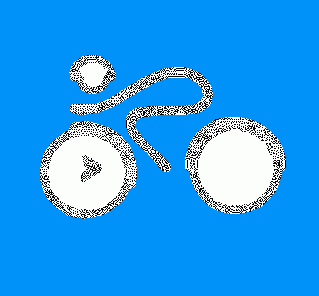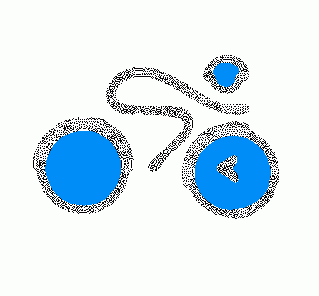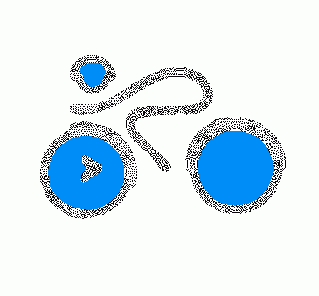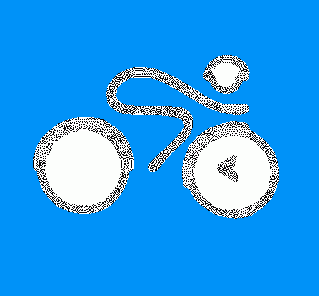| Newsletter - 2001 Archive |

|

|
Cycling Club |

|

|
| Newsletter - 2001 Archive |

|

|
Cycling Club |

|

|
Next--->
The second brevet I rode in the Netherlands (actually most of it in Germany) involved a 400 km event on May 26, 2001. It started at Lonneker, near Enschede in the eastern part. On account of the foot-and mouth disease the traditional course through the forested and hilly Veluwe area had to be canceled. John Omlo, organizer of this brevet, had selected an alternate route, which would take the eight riders into Germany to Warstein as the turnaround point. Warstein, at the northern edge of Sauerland, is the place where the famous Warsteiner beer is brewed. Registration of the participants took place between 8 and 9 pm at night at cafe Sprakel, and at 9 pm sharp we were off. This ride as opposed the 300 km brevet a week earlier, did not have any arrows on the pavement, but made extensive use of road signs and an excellent route description.
The route took us very quickly into Germany. Evening fell slowly, as if someone gradually turned down the dimmer switch. After sunset we stopped at our first control in Emsdetten, re-supplied depleted caffeine stores and water bottles. As the skies turned darker, temperatures dropped and Germany went to sleep. The stars came out, as did the moon, guiding us through the countryside. Frequently, we passed through small villages. Somewhere near Kattevenne some members of our group disappeared at great speed after everyone took what later on appeared to be a wrong turn. We ended up on a dark bike path in the forest, then somehow regrouped and collectively clued in that this was not the way to get to the next control. We then argued in a friendly way which direction to take. Mass confusion (that is if you can call eight riders a mass). Upon consulting a map -- yes, they are very useful to have along-- and determining our overall position, we did some backtracking and with an extra 20 km were able to get back on our route. Decision-making at its best!
It was after midnight by now and the darkest part of night surrounded us. We passed through Lienen, a place where I have to go back to, because it struck me as particularly picturesque. Arriving at Bad Iburg, the silhouette of the famous Teutoburgerwald with its spectacular forest became visible. Meanwhile we had split in two groups, one fast and one not so fast. Slowly, the night sky began to lose its darkness, as if someone gradually turned the dimmer switch on again. Earlier, aromas of freshly baked bread from bustling bakeries wafted through silent streets of rural villages and tickled our nostrils, tempting, and attempting us to stop for a bite. We resisted, and were not. By the time we were ready to leave the second control near Soest, Germany awoke. Morning sights and sounds greeted us. In the valleys, tatters of ground fog hanging in suspension over pastures. Slight breezes caused it to slowly float away, until it disappeared in the strengthening morning sun.
The landscape became increasingly rolling, taking us from valley bottoms, up hillsides to hill tops. Forests and fields alternating passing us (or, we them), as if someone was playing hide and seek. We rode on, and rose above the valleys, gaining both elevation and views of the wide area around us. Hilltops were littered with large windmills, evidence of a great push toward alternative energy production. As we approached Warstein, one of our riders had to slow down, because he did not feel well. Well enough to cycle on, but not enough to maintain a higher pace, so with three of us we made a morning stop in the brewer’s town, visited a Konditorei with freshly baked bread and pastry. We also collected an extra stamp, thus making this an unscheduled and unplanned control at the halfway point of this brevet. The return leg of the ride took us along the same route, the difference being that we could enjoy the scenery in broad daylight now. The scenery was indeed magnificent. Passing through large beech forests, whose tall trunks and its closed canopy resembled a large cathedral. The many birds in it sang continuously, thus adding the chimes. Spring was indeed here. It reminded me of the time I spent in Germany’s Black Forest more than thirty years ago. Continuing over hollow roads in between fields where hay was cut and dried, adding fragrance to the air, thus offsetting some of the odours that are spread by livestock barns, crops sprayers and chemical industries in the region. As we cycled north back to our starting point we gradually descended into the Lowlands.
After more than 410 kilometers and a total climb of 1750 meters (most of it consisting of bridge ramps etc) we arrived a full 24 hours later at 9 pm the next day. Tired, not really. Sleepy, neither, despite having cycled for 24 hours and after having been awake for more than 36 hours. It was marvelous ride. The weather was excellent, the company was great. The country side was varied, with rolling topography, hills and valleys. Once in a while rock outcrop of sandstone or limestone. Many small villages and towns, each with its own characteristics, but most of them with market squares, churches and Gasthoefe, and above all neatly manicured and rich in Kultur.
In terms of the cycling a great way to explore a varied landscape. Similar to the 300 km brevet, the strategy was no different. Fast paced riding between control points. Take a break of about half an hour or so, until someone gets the idea to get moving again...........and moving it is. It is obviously important to find a group riding at one’s pace. Cycling at night in a group was certainly challenging, especially where one was confined to bike paths and riding double file (instead of single). Bike paths have many obstacles and curves in them, which requires extreme alertness, especially at night. The rides are very disciplined with continuous signaling and warning about obstacles and traffic ahead. Overall, a great experience.
_